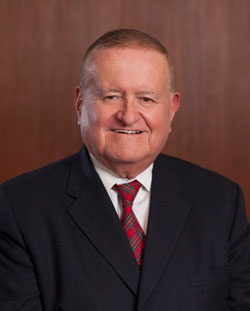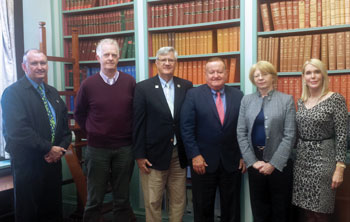ISBA Development Site
This website is for ISBA staff use only. All visitors should return to the main ISBA website.
This website is for ISBA staff use only. All visitors should return to the main ISBA website.
November 2017 • Volume 105 • Number 11 • Page 10
Thank you for viewing this Illinois Bar Journal article. Please join the ISBA to access all of our IBJ articles and archives.
Members enjoyed a guided tour of the Irish court system on the ISBA's recent trip to Ireland.

Lawyers who joined the ISBA's recent trip to Ireland were greeted by members of the Irish Supreme Court and treated to a guided tour of the Irish court system in action. I asked ISBA member and Ireland trip participant Margaret A. "Maggie" Bennett of Oak Brook to share these memories of our visit.
-RWH
____
One of the highlights of ISBA President Russ Hartigan's tour of Ireland was the opportunity to see the Irish court buildings, meet with judges and barristers, watch criminal proceedings, and enjoy a guided tour of the ancient King's Inn.
Our look at the Irish court system began at the historic Four Courts building, which was built between 1786 and 1796. The main Irish courthouse, it is located on Inns Quay in Dublin. The building houses the Irish Supreme Court, the Court of Appeals, the High Court, and the Dublin Circuit Court.
Four Courts has great historical significance as the site of the Easter Rising, an insurrection in Ireland to end British rule that occurred during Easter week in April 1916. The Four Courts complex was also occupied and partially destroyed in April 1922 by IRA forces opposed to the Anglo-Irish treaty.
 We toured this beautiful building and met with Irish Supreme Court Justice Elizabeth Dunne in her chambers. She gave us a brief history of the Irish court system and explained that the Republic of Ireland established a Court of Appeal in 2014, taking over appellate jurisdiction from the Supreme Court.
We toured this beautiful building and met with Irish Supreme Court Justice Elizabeth Dunne in her chambers. She gave us a brief history of the Irish court system and explained that the Republic of Ireland established a Court of Appeal in 2014, taking over appellate jurisdiction from the Supreme Court.
After leaving Four Courts we traveled to the Criminal Courts of Justice, the principal criminal courts building in the Republic of Ireland. In contrast to Four Courts, the Criminal Courts of Justice is a modern high-tech building that officially opened in 2010.
The courtrooms are wood paneled and maintain the English system, under which the barristers sit facing the judge while the solicitors sit with their backs to the court. During trials the defendant sits in the dock, a separate area away from counsel table. Monitors are set up throughout the courtroom for displaying exhibits during trials.
We had the opportunity to observe two bond hearings, and were surprised when the defendant took the witness stand during the bond hearing and admitted to stabbing his victim over a comment made about a sport's team! We also learned that in Ireland, defense attorneys are barristers in private practice paid by the state for representing defendants in criminal cases.
Afterwards we went to the Bar Council of Ireland. Irish barristers belong to the Bar Council, and it is their regulatory and representative body. At the spacious and modern Council building, barristers can reserve rooms for meetings and arbitration tribunals, meet with other barristers, and attend CLE seminars.
We were graciously welcomed by the Bar Council and given a tour. After lunch at the building, President Hartigan was honored with a special plaque.
During a question-and-answer session with several barristers, we learned that there is a distinction between junior and senior counsel. A senior-counsel designation is a recognition of advanced professional ability that can be a steppingstone toward a judicial appointment. Senior counsel are allowed to charge a higher fee for legal services.
We were also told that barristers in Ireland must take direction from solicitors and are not allowed to advertise. Advertising legal services would be a violation of a barrister's professional ethics. In fact, until recently barristers were unable to use business cards, which would have been considered a form of self-promotion and advertisement.
We were also given a primer on fee structures for representing criminal defendants at trials. Criminal trials are common, as plea-bargaining is not permitted in the Irish court system.
We concluded our tour at the Honorable Society of King's Inn created in 1541. The Society is responsible for the education and entry of barristers into the legal system. The King's Inn houses the School of Law, which focuses on the training of barristers. We had the privilege of a guided tour through this magnificent Georgian building located on Dublin's Constitutional Hill.
The King's Inn is composed of benchers (senior members), barristers, and students. It is known not only for its School of Law and Georgian architecture but also for collegiality and its stately Harry Potter style dining hall.
Afterwards we celebrated at a local Irish pub with a "jar" of Guinness and Irish music. A great end to a great day!
- Margaret A. Bennett
____
As Maggie mentioned, attorney advertising is not allowed in Ireland, and it is not uncommon for a prisoner to admit guilt at a bond hearing. Here are more interesting facts.
As Maggie noted, our group was honored by Mr. Paul McGarry, Chairman of the Bar of Ireland, and I was given a plaque with an inscription from Irish Barrister John Philpot Cyrran (born 1750 and died 1817). It reads, "Patriotism, Christianity, moral virtue and social duty are taught with equal exactness by every sect, and practiced with equal imperfection by all; and therefore, wherever a little interested bustling bigot appears, do not hate him, do not imitate him, pity him, if you can."
At the Fourt Courts, from left to right: ISBA member Hon. Martin J. Mengarelli of the Third Judicial Circuit, Irish Supreme Court Justice Peter Charleton, ISBA member Hon. Michael P. McCuskey of the Illinois 10th Judicial Circuit, ISBA President Hartigan, Irish Supreme Court Justice Elizabeth Dunne, and ISBA member and Oak Brook lawyer Margaret A. Bennett.